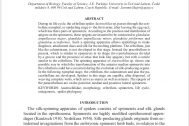Content
During its life cycle, the cribellate spider Austrochilus sp. passes through the ecribellate nymphal, or spiderling stage (= the first instar, after leaving the egg sac), which has three pairs of spinnerets. According to the position and distribution of spigots on the spinnerets, these spigots are assumed to be connected to glandulae ampullaceae major, glandulae ampullaceae minor, glandulae piriformes and glandulae aciniformes. Such a spinning apparatus allows spiderlings to make draglines, attachment discs and silk for the molting platform. The cribellum, just like the calamistrum, is not developed in this stage. Instead the precribellum is present, which is similar to spinnerets in its shape (two protuberances divided by a groove and the presence of setae that look like spigots), but with a cuticle similar to the cribellum. The spinning apparatus of Austrochilus sp. shows one possible way in which the transformation of the anterior median spinnerets into the cribellum could have occurred during the evolution of silk-producing organs. In the following nymphal stage, the cribellum, the calamistrum and also the paracribellum are developed. Spiders in this stage are capable, after dispersal, of weaving complete webs, which serve as snares as well as retreats. The spigots of the paracribellum are on the posterior median and posterior lateral spinnerets.



